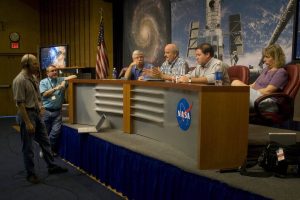|
Getting your Trinity Audio player ready...
|

For hundreds of years, scientists have studied and successfully found stars, planets, and other stellar objects. For their discoveries, they typically use ground-based equipment such as the Hubble Space Telescope. Technology is advancing steadily, and as a result of that, scientists are now able to examine phenomena like neutron stars and black holes. They can now determine whether or not there are planets like Earth. A group of international scientists, led by the University of Montreal, have suggested that there may be more ocean planets with life.
The “Ocean World” lives about 100 light years away from Earth, It is orbiting within a binary star system in the Draco constellation. The “Ocean World” is officially named, TOI-1452 b, scientists believe that the planet is 70% larger than Earth, which took 50 hours of observations to estimate. It is also believed that the planet orbits to a rhythm that is equal to seven Earth days and has a temperature not too hot or not too cold for liquid water to exist on the surface.

TOI-1452 b’s was discovered using NASA’s James Webb Space Telescope, which is the largest and most advanced telescope ever built to date. The telescope has the ability to see through large clouds of dust that block other telescopes because of its gathering of infrared light. Compared to the Hubble Space Telescope, it is 100 times more powerful, it is robust enough to look for water vapor on planets that orbit other stars.
The density currently looks to be consistent with having a very deep ocean or it’s a large rock with little or close to no atmosphere or potentially an atmosphere consisting of hydrogen and helium, according to NASA.
A study, which was just recently published in The Astronomical Journal, describes the planet that it is somewhat larger and heavier than Earth and is located in the “habitable zone” of its star, which is the region between the frost line and the “boil zone,” where liquid water is able to exist.
Researchers wanted to use JWST to investigate this exoplanet’s atmosphere in further detail and see if it really is a fantastic world with liquid water. The team claims that it is one of the few known temperate planets that truly displays traits typical of an ocean planet. This is why ruminating about it is so enticing.
Furthermore, because the star TOI-1452 b orbits in the binary star system are considerably smaller than our sun, and don’t travel too far from the planet of interest, it is likely to have a cold temperature. The authors of the study claim that this gas ball is located around 2.5 times farther away from its star partner than the sun are from Pluto.
The authors of a recently published article believe that there is a possibility of it being an “Ocean Planet,” that being, a planet that is completely covered in a thick layer of water. They have compared it to Jupiter’s moons Ganymede, and Callisto and Saturn’s moons Titan, and Enceladus, all of them are suspected to likely have subsurface global oceans.
“TOI-1452 b is one of the best candidates for an ocean planet that we have found to date,” said Charles Cadieux, a Ph.D. student at the University de Montréal. “Its radius and mass suggest a much lower density than what one would expect for a planet that is basically made up of metal and rock, like Earth.” Theorized “ocean planets” are between the sizes of Earth and Neptune, whose density can only be explained by the presence of a lot of water, which are thought to include TOI-1452 b.
Written By Lance Santoyo
Sources:
Forbes: The Webb Telescope Must Study This Unique New ‘Water World’ Close To Earth, Say Scientists
CNet: Possible ‘Ocean World’ Discovered 100 Light-Years Away From Earth
Giant Freakin Robot: Scientists Have Discovered An Ocean Planet With The Possibility Of Life
Futurism: Astronomers Discover Apparent “Ocean Planet” 100 Light-Years From Earth
Featured and Top Image Courtesy of Chad Davis Flickr Page – Creative Commons License
Inset Image Courtesy of NASA Goddard Space Flight Center Flickr Page – Creative Commons License



